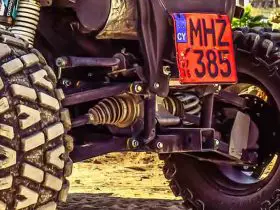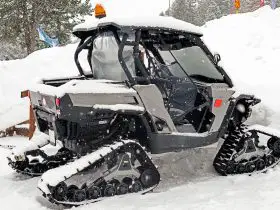Whether you’re replacing your rims for something better looking or need new ones because of damage, understanding wheel offset on your UTV is essential.
A UTV wheel offset is the measurement from the back of the hub to the edge of the rim. Wheel offset can be zero, positive, or negative, and affects the performance, safety, and ride quality of a UTV.
It’s an important measurement to understand because the wrong offset can cause issues if the wheel contacts the UTV wheel-wells or cause issues with how the UTV rides. In this article, we’ll explore what offset means, how to measure it, and detail several different causes if you wish to change this offset so you can customize your UTV and ride.
Table of Contents
What is a Wheel Offset? Why Does it Matter?
The wheel offset is a set measurement from the back of the hub to the edge of the rim. This spacing is very important as both the axle hub and rim have specific measurements that need to be met. Manufacturers always set this offset on their stock models with stock rims to ensure the best balance of safety and ride quality.
Understanding this offset is vital if you want to replace your rims or if you want to change the offset to change how your UTV rides.
There are generally three different styles of offset:
- Positive offset is where the hub is near or as flush as possible to the outside of the rim. This forces the rim back into the wheel well and gives a sleek appearance to the outside profile.
- Negative offset is where the hub is pushed back into the rim. The outer diameter of the rim is pulled out, giving the rim a “dished out” look which many rim manufacturers use to add interesting detail and dimensionality to the spokes.
- Zero offset is where the hub is the most center line with the rim, allowing for both a sleek profile and some concave texture. However, this isn’t always the “safe” bet when choosing rims, just an option.
How is a UTV Wheel Offset Measured?
Offset can be measured easily in a few minutes. If all of your four rims are matching, you only need one wheel off to measure. If you can tell the front and back are different offsets by just looking at them, remove one front and one rear.
The tools you will need are:
- A long, flat bar that’s stiff and has a square edge at the bottom. This can be anything from a measuring stick, a piece of wood, or even a chunk of metal.
- A ruler or measuring tape.
An important note: Rim manufacturers vary in using either imperial or metric measurements. It can depend on the location where the rims are made, what country they are based in, or even what the distributor wants to list down or what information they have access to.
Because of this, it is best to have both imperial and metric measurement tools at your disposal. But if you don’t have one or the other, you can get as close as you can. You can easily calculate this with an online tool. Most measurements are in common sizes, so even rough estimates are fine.
How to Measure a UTV Wheel Offset:
- It’s best to remove the tire from the rim as the tire can raise above the rim and be an issue. You could deflate the tire and break it from the bead of the rim if you’re confident in re-beading the tire later.
- Set the rim down with the front, out-facing side on the ground or workbench.
- Lay the measuring stick or any long, square material down on top of the center of the rim.
- Slide the ruler or measuring tape across the measuring stick, meeting the back of the hub. The lowest spot of the rod to the ruler is the number we’re looking for. This number is often rough in inches. The offset can be 3.5 inches or 1.65 inches for example. Whatever the number comes out to, take note of it. That is in the inner measurement.
- Next, take the measurement of the rim thickness itself. The most common size for UTV rims are 7 inches, despite the tire being wider.
- Take that measurement and subtract the width of the rim. For example: 3.5 – 7 = 3.5 inches. Note: It’s best to convert these measurements into millimeters so you can have both to reference when shopping.
Please note: If measuring in inches, they might not be perfect to a set single digit. 1.65 inches or 3.89 inches, for example. Don’t worry too much about if they are like this. Often offset is measured with millimeters, and sometimes they are not set to a double-digit either.
The above example of 3.5 inch offset is an example of zero offset rims. This means the hub of the rim meets the hub of the axle in the perfect centerline of the rim and tire. Anything more would mean positive offset, anything less would be negative offset.
These numbers are often packed down to a ratio. The first number in the ratio is the inner measurement, the second number the outer measurement. Here’s an example: 5+2, which makes the rim a positive offset rim. Positive offset rims often have larger numbers in the front of the offset measuring. For example, 5+2. Or in the cases of metric measurements, they will have “+10 positive offset”. Negative offset, the opposite with smaller numbers in the front.
This 5+2 offset is a standard offset for many rims on UTVs. If your rims have a different offset, this positive offset is often the front rims. Rear rims that have a different offset are due to a difference in rear axles, but we’ll explore that further on.
In case you are measuring in metrics and want to know the notation used there: The offset number is often the difference from the centerline of the rims. So zero offset rims are always just zero offset. Positive offset is called “+10 positive offset” or 10mm positive offset from the centerline of the rim. Negative can be “-47mm negative offset” which is the rear moved 47mm back from the centerline.
UTV Bolt Patterns
Bolt patterns are essential to know as well when purchasing rims, and not just the bolt pattern but the distance between each hole dictates what rims you can fit onto your UTV.
How to Measure Bolt Pattern.
You will need a small ruler or measuring tape that can fit into the inner-diameter of your rim and contact the bolt holes inside. It is best to have a millimeter measuring tape as these sizes are only available in metrics. However, if your imperial measuring tape is accurate, you can calculate it and estimate the closest millimeter size.
First, identify the number of holes. They come in three common groups: Three, four, and five lug holes. Each has their own different ways of measuring the space between.
Measuring Three Lug Pattern:
- This one is the trickiest. Through the center of each bolt hole, try to imagine a line or even draw a circle connecting the three holes. It might help you out to find a container lid or some circle that can fit in the center of these holes perfectly. You can either draw a line or measure that circle.
- Take your measuring tape and measure across the hub to the edges of these lines. That is your measurement. For example: 90mm, which is a very common size for these three lug patterns as they are smaller rims.
Measuring Four Lug Pattern:
- This one is the easiest. Identify adjacent holes across from the hub.
- Take your measuring tape across the holes and focus on the center of the open holes. From one center to the next is the diameter between each. For example: 110mm is the most common sizing.
Measuring Five Lug Pattern:
- This one can be weird, but not as tricky as the three lug pattern. First, identify two holes adjacent over the hub. As they are not perfectly centered, that’s fine.
- Lay your measuring tape across these holes. For one, aim for the center of the opening hole and keep your mark there steady.
- Now adjust the other end of the measuring tape to the edge of the second hole. Do note: You want to measure to the edge that’s facing away from the hub as much as possible. The measurement here might not seem much different than on the four lug pattern, commonly 110mm. But as this is an angled measurement, that means the lug pattern itself is wider than that on the four lug pattern.
These lug measurements are often noted as follows: 3/90, 4/110, and 5/110. The first number is the number of lugs holes in the rim, the second is the diameter across from them.
Now that you have the knowledge to measure the offset of your rims and the sizing of the bolt pattern, you can easily buy rims that perfectly match your UTV. In some rare cases, especially if your UTV has been customized or upgraded, these sizes can be different so please do check if you are suspicious.
Rear Axle Can Cause a Big Difference
Sometimes the rear axle can dictate the difference between the front and rear rims, as we’ve noted before. Here’s a quick guide on what to expect from the two different types of rear axles:
Straight Rear Axles:
- Front rims will often have positive offset as this can be advantageous in giving the rider a better feel in the steering.
- Rear rims with straight rear axles will often have negative offset as the axles tend to be thinner in length across so the wheels stick out more.
Independent Rear Suspension:
While not noting the axle itself, this means the axle design is different. There are two different aspects to this kind of setup:
- In one case, front and rear rims can be of different widths. These setups often have the same positive offset to the rims, while the rears have a deeper rim. The outside will look exactly the same front to rear, but the rear tire will be deeper in the wheel well.
- In the other case, all four rims and tires are the same width. However, their offsets can be different or the same depending on whoever installed the rims.
Changing your Rims
Now, what if you want to change your rims for a different offset? Changing your rims can be beneficial to the ride of your UTV and the looks overall. Or perhaps one of your rims broke and you want to order a replacement. Let’s go over what you should be aware of.
Knowing the Numbers
Take your measurements as we’ve guided you through in this article. The size of the rim, the offset ratio in either imperial or metric, the bolt pattern and size of the bolt diameter. Once you have this, you can go ahead and order the rims of your choosing.
When choosing a tire, keep note of the same rim size and the height of the tires in terms of how the offset as certain offsets and tire heights can cause issues. A reputable tire store will help sort everything out for you.
Changing Offset
Now we get to the tricky part of offset. The easiest way to swap rims on your UTV is using exactly what the manufacturer installed originally. It’s good to understand that you have the ability to choose the offset you wish for your UTV. Most will accommodate a different offset. However it’s wise to ask the tire dealer or people who have swapped offsets to see what the difference does. If you want to change the ride or look of your UTV with offset, here’s a guide:
Adding Positive Offset
If your rims have either zero offset or negative offset, and you wish for a sleeker look or shorter width of your wheels, the positive offset is the way to go.
- Adding positive offset to the front can give better steering feel, faster steering, and tighter turning circles.
- Adding positive offset in the rear wheels can be an issue as clearance around brakes and wheel wells can be tight. Measure the distance of your current wheel to everything around it on the UTV.
Adding negative offset
One of the more popular modifications in offset is going for deep negative offsets. This can add a different dimension of looks to your rims and a wider track of your wheels.
- Adding negative offset in the front can give you more accurate steering to the detriment of faster steering. Also, the steering feel might be lower, but this can be a positive if the feedback you currently feel in the steering wheel is too great.
- Adding a negative offset to the rear can give more clearance around the tire if you have situations of rubbing on the inside of the wheel well.
If you have a straight axle, you most often will run a negative offset to allow the tire to be moved away from the axle itself. In some cases, this offset is already too great. If you’re wanting to go about adding a deeper look or want a wider stance in the rear, a wider rim and tire set is the way to go in this case.
If your rear suspension is independent, you are free to choose whatever combination you wish. However, it is best to choose an offset that matches from front to rear. For example, if you add a negative offset to the front, add the same negative offset to the rear so the wheels are level with each other. Sometimes when stock front rims run positive offset, going negative can make them poke out too much from the rear wheels.
When Is Offset a Problem?
If you just purchased a used UTV that the owner customized, or just changed from stock rims, what problems should you look for?
- If the tires are rubbing or bottoming out on a low hanging part of the wheel well, there might be too much positive offset making the rim too deep into the body. Or, the width of the tire with too much positive offset is the issue.
- If you feel there’s not enough feedback in the steering wheel, or perhaps you want a tighter turning circle, the front rims might have too much negative offset.
UTV Wheel Offsets: Roundup
We hope this guide gives you everything you need to know about UTV wheel offset. Knowing how to measure your current offset and the bolt pattern size is important when purchasing new rims, either modifying the look and feel of your UTV or simply ordering the same sized replacements.
https://www.pureoffroad.com/atv_wheel_offset_guide.htm
https://www.kjmotorsports.com/lifestyle/blog/wheel-offsets-made-easy/







